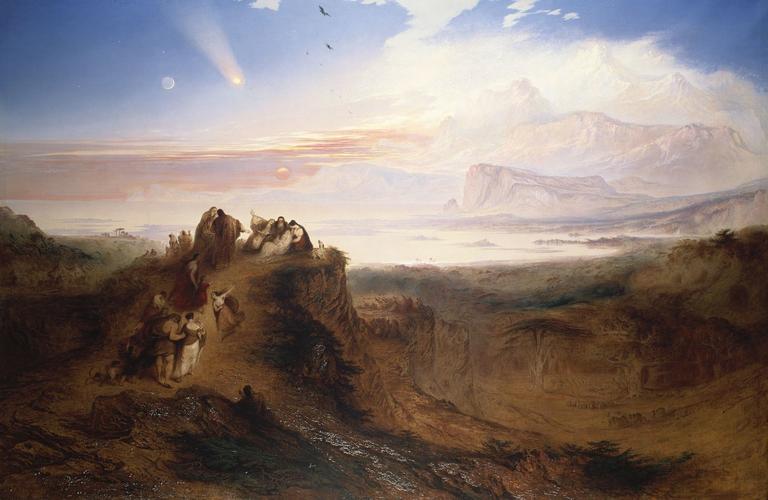-
1 of 253523 objects
The Eve of the Deluge Signed and dated 1840
Oil on canvas | 144.3 x 218.5 cm (support, canvas/panel/stretcher external) | RCIN 407176
-
In this Old Testament scene the white-bearded patriarch Methuselah lies on a raised promontory surrounded by the family of Noah. He has instructed Noah to open a prophetic scroll which, according to the contiguity of the sun, moon and comet in the sky above, foretells the arrival of the catastrophic flood sent by God. Circling ravens add to the sense of foreboding, while antediluvian revellers continue their dancing in the middle distance, oblivious of the devastation to come. Martin had published a small mezzotint of the same subject to illustrate John Galt's The Ouranoulogos or The Celestial Vision in 1833.
From humble beginnings in Newcastle-Upon-Tyne where he first worked as heraldic painter to a coach builder, John Martin moved to London and established a successful career as a painter and illustrator, engraver and engineer. By the time of this painting his reputation was well established - he had first exhibited at the Royal Academy in 1811 and his paintings were hugely popular with the public.
Prince Albert was probably introduced to Martin's work and perhaps influenced in his appreciation by his uncle Leopold I, King of the Belgians, who during the short period of his marriage to Princess Charlotte (1816-17) had employed Martin as Historical Landscape Painter. The connection continued following Leopold's move to Brussels in 1831: Martin's The Fall of Nineveh was bought by the Belgian government in 1833; he became a member of the Belgian Academy and later of the Order of Leopold.
Prince Albert first visited Martin's studio in 1839, before his marriage. He returned several times once he had come to live permanently in England the following February. The artist's son Leopold remembered how John Martin respected the Prince's art-historical knowledge: 'what pleasure he received and what great benefit he reaped from the enlightened criticisms of the Prince. They deeply impressed him as being judicious, thoughtful and kind, indicating a truly refined and extensive knowledge of art' (Balston 1947, p.202-3). According to Leopold it was Prince Albert who suggested, on seeing Martin's The Deluge (New Haven, Yale Center for British Art) during one of these visits, that he should paint a trilogy of the story, with The Eve of the Deluge forming the prelude and The Assuagement of the Waters (San Francisco Museum of Fine Arts) depicting the aftermath. The Assuagement was commissioned by the Duchess of Sutherland, Mistress of the Robes to Queen Victoria. The Eve of the Deluge was originally hung in Prince Albert's Dressing Room at Buckingham Palace and the mezzotint reproduction, produced two years after the painting, was dedicated to the Prince.
This painting typifies the early Romantic taste for the sublime and the visionary. Martin's paintings were highly imaginative and often used dramatic viewpoints to emphasise the insignificance of humans in the vast scale of nature. He may have witnessed the Great Comet of 1811-12 and the return of Halley's Comet in 1835. The biblical flood was a controversial subject during this period, as contemporary discoveries in geology and palaeontology were giving rise to suggestions that the earth was older than an historical reading of the Old Testament would maintain. Martin published an eight-page pamphlet to accompany the three paintings, citing a large number of esoteric literary sources as influences and quoting long passages from Byron's 'sublime poem' Heaven and Earth.
Text adapted from Victoria and Albert: Art & Love, London, 2010Provenance
Purchased by Prince Albert in 1841 (£350); recorded in the Prince Consort's Dressing Room at Buckingham Palace in 1868
-
Creator(s)
Acquirer(s)
-
Medium and techniques
Oil on canvas
Measurements
144.3 x 218.5 cm (support, canvas/panel/stretcher external)
178.5 x 253.4 x 15.0 cm (frame, external)
Category
Object type(s)
